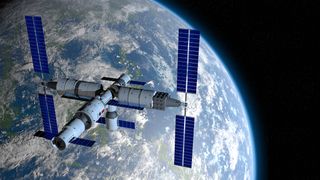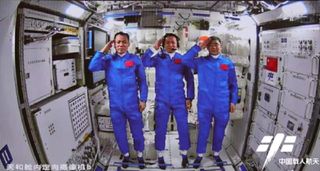China's space station, Tiangong: A complete guide
The three-module Chinese space station hosts many scientific experiments.

China's space station, Tiangong, orbits Earth at an altitude between 217 and 280 miles (340 to 450 kilometers), approximately the same orbital height as the International Space Station (ISS).
The Chinese Manned Space Agency (CMSA) built Tiangong — which means "Heavenly Palace" — in low Earth orbit, launching each of the three modules that make up the station between 2021 and 2022. The CMSA launched Tianhe, the first station module, on April 28, 2021, the second module Wentian on July 24, 2022, and the third module Mengtian on Oct. 31, 2022.
The first crew to visit China's space station, Shenzhou 12, arrived on June 16, 2021, when only the core module Tianhe was in orbit. The taikonauts — Chinese astronauts — spent 90 days aboard Tianhe, approximately three times longer than any previous Chinese crewed spaceflight.
The CMSA hopes to keep Tiangong continuously inhabited by a minimum of three astronauts for at least a decade. Over that stretch, the space station will host many experiments from both China and other countries.
Related: The latest news about China's space program
China space station FAQs
Is the Chinese space station complete?
The Chinese space station was completed on Nov. 5, 2022, following a maneuver to shift the recently arrived Mengtian module to its permanent docking port.
Why does China have its own space station?
China is excluded from the ISS program, largely due to U.S. concerns over the Chinese space programs' links with the People's Liberation Army, the military branch of the ruling Communist Party. In 2011, Congress prohibited NASA from cooperating substantially with its Chinese counterpart without express prior authorization. This law, known as the Wolf Amendment, makes it very difficult for China to participate in the ISS program, if the nation even wishes to do so.
China is not an ISS partner, and no Chinese astronaut has ever visited the venerable outpost. As such, the nation's only option for off-Earth work was to build its own space station.
Is the Chinese space station bigger than the ISS?
The Chinese space station is much smaller than the International Space Station with only three modules, compared with 16 modules on the ISS, which has hosted astronaut crews continuously since November 2000.
Tiangong space station specifications
Tiangong is much smaller than the International Space Station, with only three modules compared with 16 modules on the ISS. Tiangong is also considerably lighter than the ISS, which weighs about 400 tons (450 metric tons); the Chinese station is about 20% as massive.
The 54-foot-long (16.6 meters) Tianhe module launched with a docking hub that allows it to receive Shenzhou crew and Tianzhou cargo spacecraft. A large robotic arm helped position the Mengtian and Wentian modules and assists astronauts during spacewalks.
Tianhe is much larger than the Tiangong 1 and 2 test space labs that China launched in the last decade and nearly three times heavier, at 24 tons (22 metric tons). The new Tiangong, combined with visiting Shenzhou and Tianzhou craft, provides a wealth of usable space for China's astronauts. Indeed, its occupants will feel like "they will be living in a villa," compared with how little space was available in China's previous space labs, Bai Linhou, deputy chief designer of the space station, told CCTV back in June 2021.

Tianhe features regenerative life support, including a way to recycle urine, to allow astronauts to stay in orbit for long periods. It is the main habitat for the astronauts and also houses the propulsion systems needed to keep the space station in orbit.
Tiangong will be joined by a huge, Hubble-like space telescope, which will share the space station's orbit and be able to dock with it for repairs, maintenance and possibly upgrades. Named Xuntian, which translates to "survey the heavens," the telescope will have a 6.6-foot (2 m) diameter mirror, slightly smaller than that of Hubble, but will have a field of view 300 times greater. Xuntian will aim to survey 40% of the sky over 10 years using its huge, 2.5-billion-pixel camera.
The space station could potentially be expanded to six modules, if everything goes according to plan. "We can further expand our current three-module space station combination into a four-module, cross-shaped combination in the future," Bai told CCTV. The second Tianhe core module could then allow two more modules to join the orbital outpost.
Tiangong vs ISS
| Header Cell - Column 0 | Chinese space station Tiangong | International Space Station (ISS) |
|---|---|---|
| Size | 180 feet (55 meters) long | 356 feet (109 meters) long |
| Weight | 77 tons (70 tonnes) | 450 tons (408 tonnes) |
| Number of modules | 3 | 16 |
Tiangong pathfinding missions
If the name "Tiangong" sounds familiar, that's because China's two pathfinder space labs also shared that name. Tiangong 1 reached Earth orbit in September 2011 and hosted two crewed missions, Shenzhou 9 in June 2012 and Shenzhou 10 in June 2013. Tiangong 2 launched in September 2016 and welcomed the Shenzhou 11 astronauts aboard for a 30-day mission the following month.
Neither of the space labs exists today; Tiangong 1 made an uncontrolled reentry to Earth's atmosphere in April 2018, burning up over the Pacific Ocean. And Tiangong 2 was also steered to a planned demise, over the Pacific, in July 2019.
Tiangong's project history
Tiangong's path to orbit has been a long one. The project was first approved in 1992, after which the country set about developing the Shenzhou crew spacecraft and the Long March 2F rocket to send astronauts into space. Yang Liwei became China's first astronaut in space in October 2003 and made China the third country in the world to independently send humans into orbit.
China expressed interest in joining the International Space Station partners, but the possibility was ended by the 2011 decree passed by U.S. lawmakers, which effectively banned NASA from coordinating directly with China or any Chinese-owned company. This means direct collaboration between NASA and Chinese space stations is strictly prohibited, making the prospect of sending U.S. astronauts to Tiangong (or Chinese astronauts to the ISS) virtually impossible.
To be able to build and operate a crewed space station, China first needed to test out crucial space station systems, including life support and technologies for rendezvous and docking of spacecraft in orbit while traveling 17,448 mph (28,080 kph). To accomplish this, China launched the 9-ton (8.2 metric tons) Tiangong 1 space lab in 2011 and subsequently sent the uncrewed Shenzhou 8 and then the crewed Shenzhou 9 and 10 to join Tiangong 1 in orbit.
The upgraded but similarly sized Tiangong 2 launched in 2016 and hosted the two-astronaut crew of Shenzhou 11 for just over a month, setting a new national record for human spaceflight mission duration.
As the China Manned Space Agency checked off these initial milestones, the agency was also focused on developing new, larger Long March heavy-lift rockets to make a space station possible. The Long March 5B was designed specifically to launch the huge space station modules into low Earth orbit. The same rocket was the source of one of the largest uncontrolled reentries in recent decades following the launch of Tianhe in late April 2021. The launches of Mengtian and Wentian featured similar uncontrolled Long March 5B falls, drawing further criticism from the U.S. and other nations.
In 2014 China completed its new, coastal spaceport at Wenchang, specifically to launch these larger-diameter rockets, which need to be delivered by sea.
Additional resources
You can find out where the Tiangong space station is with these helpful resources from N2YO.com. Explore Tiangong with this interactive virtual exhibit from the China Manned Space Agency.
Bibliography
science.nasa.gov. (n.d.). PRC FAQ for ROSES | Science Mission Directorate. [online] Available at: https://science.nasa.gov/researchers/sara/faqs/prc-faq-roses [Accessed 11 Aug. 2023].
www.cctvplus.com. (2021). China-Shenzhou-12/Living Conditions. [online] Available at: https://www.cctvplus.com/archive/20210617/8204732.shtml#[Accessed 11 Aug. 2023].
Xiaoci, D. (2021). China’s space station recycles 66 liters of urine in 3 weeks to support crew - Global Times. [online] www.globaltimes.cn. Available at: https://www.globaltimes.cn/page/202107/1227953.shtml[Accessed 11 Aug. 2023].
Join our Space Forums to keep talking space on the latest missions, night sky and more! And if you have a news tip, correction or comment, let us know at: community@space.com.
Get the Space.com Newsletter
Breaking space news, the latest updates on rocket launches, skywatching events and more!

Andrew is a freelance space journalist with a focus on reporting on China's rapidly growing space sector. He began writing for Space.com in 2019 and writes for SpaceNews, IEEE Spectrum, National Geographic, Sky & Telescope, New Scientist and others. Andrew first caught the space bug when, as a youngster, he saw Voyager images of other worlds in our solar system for the first time. Away from space, Andrew enjoys trail running in the forests of Finland. You can follow him on Twitter @AJ_FI.
